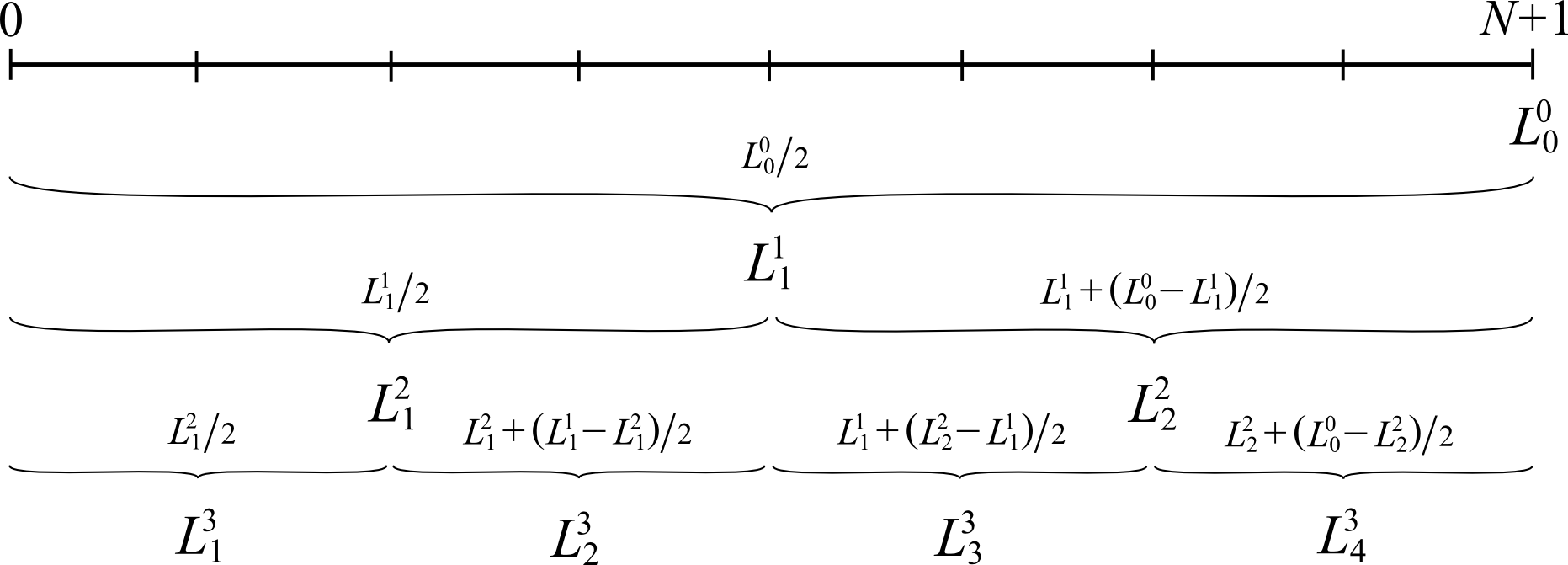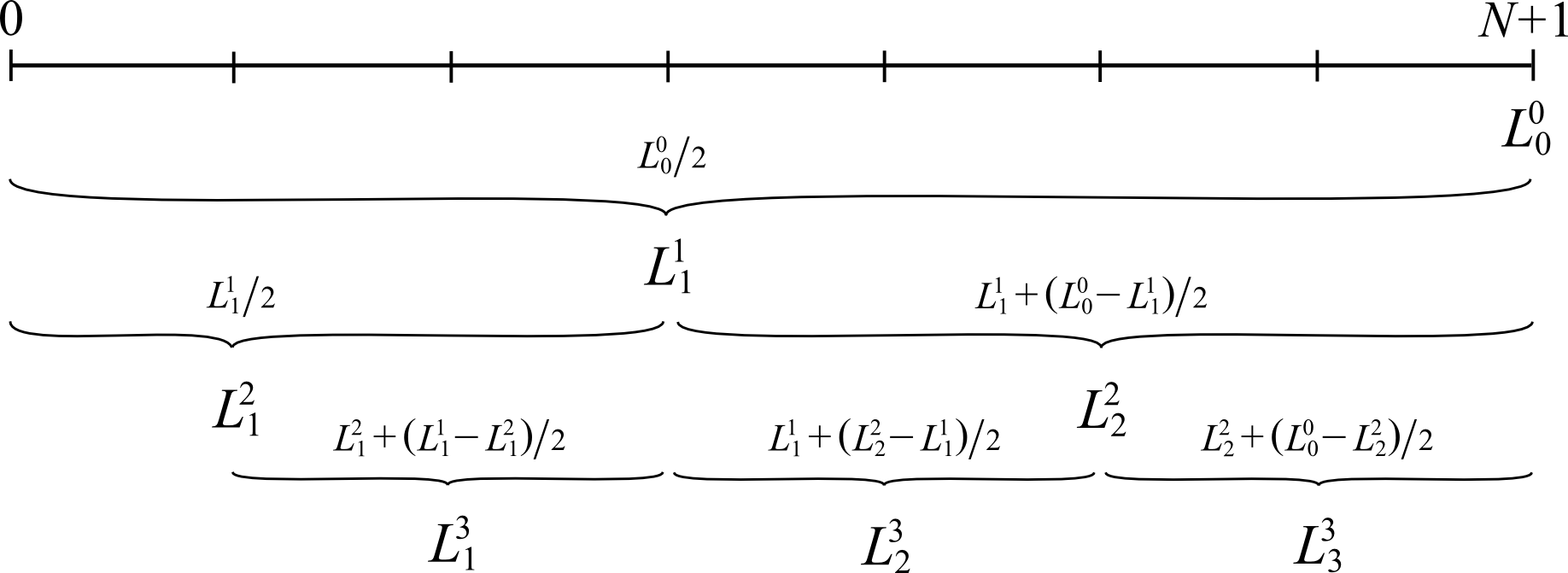NAG Library Routine Document
G05XEF
1 Purpose
G05XEF takes a set of input times and permutes them to specify one of several predefined Brownian bridge construction orders. The permuted times can be passed to
G05XAF or
G05XCF to initialize the Brownian bridge generators with the chosen bridge construction order.
2 Specification
| INTEGER |
BGORD, NTIMES, NMOVE, MOVE(NMOVE), IFAIL |
| REAL (KIND=nag_wp) |
T0, TEND, INTIME(NTIMES), TIMES(NTIMES) |
|
3 Description
The Brownian bridge algorithm (see
Glasserman (2004)) is a popular method for constructing a Wiener process at a set of discrete times,
, for
. To ease notation we assume that
has the index
so that
. Inherent in the algorithm is the notion of a
bridge construction order which specifies the order in which the
points of the Weiner process,
and
, for
, are generated. The value of
is always assumed known, and the first point to be generated is always the final time
. Thereafter, successive points are generated iteratively by an interpolation formula, using points which were computed at previous iterations. In many cases the bridge construction order is not important, since any construction order will yield a correct process. However, in certain cases, for example when using quasi-random variates to construct the sample paths, the bridge construction order can be important.
3.1 Supported Bridge Construction Orders
G05XEF accepts as input an array of time points
at which the Wiener process is to be sampled. These time points are then permuted to construct the bridge. In all of the supported construction orders the first construction point is
which has index
. The remaining points are constructed by iteratively bisecting (sub-intervals of) the
time indices interval
, as
Figure 1 illustrates:
Figure 1
The time indices interval is processed in levels
, for
. Each level
contains
points
where
. The number of points at each level depends on the value of
. The points
for
and
are computed as follows: define
and set
By convention the maximum of the empty set is taken to be to be zero.
Figure 1 illustrates the algorithm when
is a power of two. When
is not a power of two, one must decide how to round the divisions by
. For example, if one rounds down to the nearest integer, then one could get the following:
Figure 2
From the series of bisections outlined above, two ways of ordering the time indices
are supported. In both cases, levels are always processed from coarsest to finest (i.e., increasing
). Within a level, the time indices can either be processed left to right (i.e., increasing
) or right to left (i.e., decreasing
). For example, when processing left to right, the sequence of time indices could be generated as:
while when processing right to left, the same sequence would be generated as:
G05XEF therefore offers four bridge construction methods; processing either left to right or right to left, with rounding either up or down. Which method is used is controlled by the
BGORD parameter. For example, on the set of times
the Brownian bridge would be constructed in the following orders:
- (processing left to right, rounding down)
-
- (processing left to right, rounding up)
-
- (processing right to left, rounding down)
-
- (processing right to left, rounding up)
-
The four construction methods described above can be further customized through the use of the input array
MOVE. To see the effect of this parameter, suppose that an array
holds the output of G05XEF when
(i.e., the unmodified bridge construction order as specified by
BGORD). Let
be the array of all times identified by
MOVE, and let
be the array
with all the elements in
removed, i.e.,
Then the output of G05XEF when
is given by
When the Brownian bridge is used with quasi-random variates, this functionality can be used to allow specific sections of the bridge to be constructed using the lowest dimensions of the quasi-random points.
4 References
Glasserman P (2004) Monte Carlo Methods in Financial Engineering Springer
5 Parameters
- 1: BGORD – INTEGERInput
On entry: the bridge construction order to use.
Constraint:
, , or .
- 2: T0 – REAL (KIND=nag_wp)Input
On entry: , the start value of the time interval on which the Wiener process is to be constructed.
- 3: TEND – REAL (KIND=nag_wp)Input
On entry: , the largest time at which the Wiener process is to be constructed.
- 4: NTIMES – INTEGERInput
On entry: , the number of time points in the Weiner process, excluding and .
Constraint:
.
- 5: INTIME(NTIMES) – REAL (KIND=nag_wp) arrayInput
On entry: the time points, , at which the Wiener process is to be constructed. Note that the final time is not included in this array.
Constraints:
- and , for ;
- .
- 6: NMOVE – INTEGERInput
On entry: the number of elements in the array
MOVE.
Constraint:
.
- 7: MOVE(NMOVE) – INTEGER arrayInput
On entry: the indices of the entries in
INTIME which should be moved to the front of the
TIMES array, with
setting the
th element of
TIMES to
. Note that
ranges from
to
NTIMES. When
,
MOVE is not referenced.
Constraint:
, for
.
The elements of
MOVE must be unique.
- 8: TIMES(NTIMES) – REAL (KIND=nag_wp) arrayOutput
On exit: the output bridge construction order. This should be passed to
G05XAF or
G05XCF.
- 9: IFAIL – INTEGERInput/Output
-
On entry:
IFAIL must be set to
,
. If you are unfamiliar with this parameter you should refer to
Section 3.3 in the Essential Introduction for details.
For environments where it might be inappropriate to halt program execution when an error is detected, the value
is recommended. If the output of error messages is undesirable, then the value
is recommended. Otherwise, if you are not familiar with this parameter, the recommended value is
.
When the value is used it is essential to test the value of IFAIL on exit.
On exit:
unless the routine detects an error or a warning has been flagged (see
Section 6).
6 Error Indicators and Warnings
If on entry
or
, explanatory error messages are output on the current error message unit (as defined by
X04AAF).
Errors or warnings detected by the routine:
-
On entry, .
Constraint: , , or
-
On entry, .
Constraint: .
-
On entry, and .
Constraint: .
-
On entry,
and
.
Constraint: the elements in
INTIME must be in increasing order.
On entry, and .
Constraint: .
On entry, , and .
Constraint: .
-
On entry, .
Constraint: for all .
On entry, and .
Constraint: for all .
-
On entry,
for
and
.
Constraint: all elements in
MOVE must be unique.
7 Accuracy
Not applicable.
None.
9 Example
This example calls G05XEF,
G05XAF and
G05XBF to generate two sample paths of a three dimensional free Wiener process. The array
MOVE is used to ensure that a certain part of the sample path is always constructed using the lowest dimensions of the input quasi-random points. For further details on using quasi-random points with the Brownian bridge algorithm, please see
Section 2.6 in the G05 Chapter Introduction.
9.1 Program Text
Program Text (g05xefe.f90)
9.2 Program Data
None.
9.3 Program Results
Program Results (g05xefe.r)


